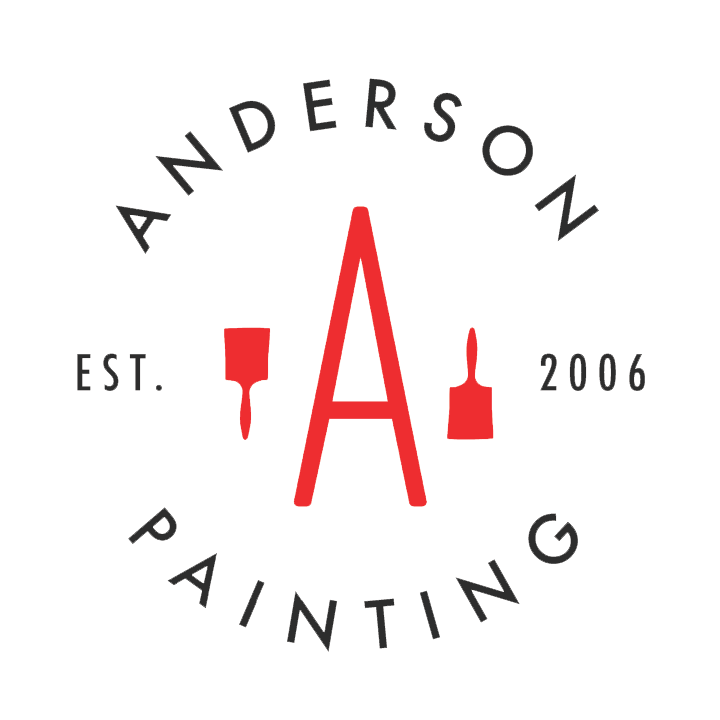Interior Painting Tips for New Homeowners

When you start living in your new home, you’ll want to make it “your own.” Repainting the interior in your preferred colors is a simple way of doing this. Many homeowners decide to tackle this project themselves, while others choose to hire professionals.
The seasoned painting professionals at Anderson Painting have gathered the most important interior painting tips for beginners if you plan on doing a DIY project. We also encourage you to consider working with professionals from the start of the project, as this is the best way to achieve the desired results.
Prevent Dried-Out Paint
As you work, it’s highly possible that you’ll let your paint dry out accidentally. This can be frustrating and wasteful. Prevent the paint from drying out by covering the paint can while you work. You can also consider throwing some clean golf balls in the can to fill the remaining air space. You can place plastic wrap under the lid, or even better, store the paint can upside down in addition to following all the other tips.
Mix the Paint Properly
You might ask yourself, “When painting a house interior, where do you start?” A good place to begin is to prepare your paint for use. Before you apply paint, you should first stir it.
You can buy stirrers from where you buy your paint, but don’t go straight to opening the paint lid and stirring. It will actually help if you drill a few holes into the stirrer. This step may seem odd, but this encourages the paint to flow through your stirrer, aerating the paint like a whisk and ensuring an even mixture.
Select the Right Primer
When preparing your house for interior painting, you must include primer in the process. But what primer should you use?
An oil-based primer is a good option for painting smoke-saturated or water-damaged paneling or walls. If, on the other hand, you are painting new drywall, stick to water-based primer.
Make sure you don’t skip the primer, as it gives your wall an even base before applying the color. It also hides imperfections.
The existing paint on the wall also affects the primer to use. For example, use an oil-based primer if you are painting over oil-based paint. To distinguish the type of paint on the wall, just soak a cotton ball in some rubbing alcohol. Rub it on a small part of the wall. The paint is latex if there is paint residue on the cotton ball. If you don’t see residue, it is oil paint.
Know How to Avoid Stripes and Streaks
One of the most useful interior painting tips for beginners is avoiding stripes. If you don’t use the right painting methods, it is very easy to leave paint stripes or streaks on the walls accidentally. But this is surprisingly easy to avoid when you know what to do.
Stripes occur when you roll over paint that has already started to dry. Being aware of this simple tip enables you to prevent the stripes by keeping the edge wet. To do so, paint the wall’s full height before moving over just a little. This allows you to overlap your previous stroke or roll with the current one.
As you paint, move backward if necessary to even out runs or thick spots. You should also take care to position the roller so that the open side of the frame faces the already-painted area. This decreases the pressure on the open side, reducing the risk of leaving paint ridges. Keeping the roller sufficiently wet with paint will also help reduce stripes and is a simple and important part of interior house painting tips. Make sure the roller is always half-loaded at a minimum.
Add Texture With a Longer Nap
The nap refers to the fabric material on the roller. The length of your nap will affect how the paint looks. If you want to add texture in the form of stippling, opt for a longer nap of about ¾ inches. If you want the paint surface to look smooth, opt for a nap of between ¼ and ½ an inch.
Paint the Trim Before the Ceiling and Walls
A professional painter will always advise you to start with the trim. The trim is faster and easier to tape off than the walls.
Remember that painting the trim doesn’t have to be neat if you are going to paint the walls, too. Just ensure the wood has a smooth finish, as you’ll cover it with the wall paint later. This interior painting tip gives you one less thing to worry about.
Combine Several Cans of Paint for an Even Color
Many homeowners struggle to get consistent color on their walls. Even if every can of paint you have is supposedly the same color, that doesn’t guarantee exactly the same shade. But luckily, you can follow interior house painting tips to prevent this issue.
You can simply grab a large bucket and combine as many cans of paint as you need. Mix the contents of the cans thoroughly and use the final mixture. Of course, this requires you to estimate how much paint you’ll need, but that just requires some simple calculations.
You May Not Need to Wash Your Rollers or Brushes
After you finish painting for the day, the natural next step is to wash your rollers and brushes. You probably assume you want to remove every drop of paint from these tools, so they can last longer and function better. However, this is not always the case.
One interior house painting tip about cleanup involves skipping this step when using latex paint. Latex paint dries slowly, especially in colder temperatures. So, you can wrap the brushes and rollers in plastic or foil. Then, place them in the fridge until you are ready to use them again. Just make sure to give the rollers and brushes enough time to warm back up before you start painting again.
Cut Painter’s Tape Before Removing It
Using painter’s tape is one important part of answering the question, “How do I prepare my house for interior painting?” Painter’s tape is extremely useful for making sure you have clean and distinct lines. Still, removing it may be a challenge if you are new to painting.
If you simply pull off the painter’s tape, some paint will come with it. This leaves you with an uneven finish.
Instead, you should first let the paint dry for a minimum of 24 hours. Grab a box cutter or utility knife and slice carefully through the film. It’s best to start this process in a hidden area, so you confirm the paint is dry enough and you can safely remove the entire strip of tape.
The Best Tip: Work With Professionals From Start to Finish
These interior painting tips will enable you to handle the project yourself. However, you will see better results and get the job done faster if you hire professionals.
For one thing, you don’t need to worry about following all these tips perfectly. With professionals, you get peace of mind knowing that they follow all the best practices of interior painting.
Yes, you can try to paint your home’s interior yourself and hire professionals when you encounter problems along the way. Still, you may end up spending more time and money, especially if you realize that your walls need repairs before repainting.
When you hire professionals to repaint your interior, they will have all the supplies needed for every part of the process, from preparation to painting. Therefore, you don’t even need to pay for materials you probably won’t need in the near future.
Upgrade your property with paint and work with a team who can tackle your interior painting project from start to finish. Get carpentry services before a new paint job with the same contractor—that’s right, we do much more than painting. Reach out to Anderson Painting and get a quote for your upcoming home improvement projects.



